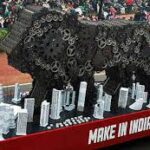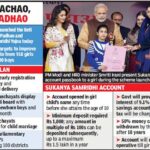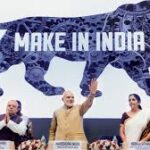Branded Nation: Are We Unwittingly Walking Into A Brand-trap?
In the aftermath of the 2014 elections, the Congress kept mentioning that it got blown away by BJP’s marketing blitzkrieg. It should not have come as a surprise to the Congress party though, since the direction of BJP’s strategic thinking was more or less set during A.B. Vajpayee’s tenure as the PM.
The failure of the India shining campaign made the Congress complacent and the BJP resilient. During the ten years they were away from power the BJP practiced and perfected the craft. Finally mounting the attack with its most potent weapon! The sustained digital presence that started with veteran leader L.K. Advani, the share of mind/conversation and something all marketers swear by – on-ground connect; all proved to be gold.
No doubt it has worked for BJP the political party and catapulted it into government. The think-tank reckons it might just work for the government as well.
A government publicizing its schemes and initiatives is nothing new. The Modi government in under an year has kicked off and launched several such schemes and initiatives with much fanfare.
A marked change from earlier has been the ‘Go to Market’. Each one of the initiatives has been supported with a well thought communication plan and activations. Whether it is the Swatch Bharat Abhiyan, the Make in India or the Pradhan Mantri Jan Dhan Yojna every element that could have been branded has been. There has also been a flurry of war cries, rallying cries and punch lines such “Minimum Government and Maximum Governance”, “No Red Tape, Only Red Carpet” etc.
The government needs to tread carefully in order not to fall into its own ‘Brand-trap’.
India as a nation has traditionally been a reluctant marketer and this new aggressive approach has been and should be accorded a cautious welcome both from within and from outside the country. After all, if one of the world’s largest markets has to get its rightful share of the investment pie the helmsmen need to do whatever it takes to catch the world’s eye. Having said that, as with any other product or service the product experience has to back the claim.
All marketing has an element of hyperbole in it. It is for the marketers to ensure that the product lives up to the promises that are made. Regardless of who and where ‘dissonance’ is a concept that all marketers need to be wary of. Few would disagree that in the current context brands, though created by marketers are ‘co-managed’ by the consumers. Therefore, while it is good to see the slick marketing plans for initiatives, it is also important to ensure that the surrounding ‘buzz’ and the ‘conversations’ about need to be managed better and need to have a positive ‘slant’.
As someone once said “A hen lays an egg and cackles, the catfish lays a million without making a sound. We all know whose eggs we eat!”
The Importance of Being Earnest
A promise to my readers and to myself, this will be last of my posts that have a reference to AAP (Aam Aadmi Party). I shall be honest here, the poll results and AAPs performance in the Delhi Elections was certainly mind blowing.
The biggest message that I drew out of the results was “It is indeed OK to make a mistake” the Ryder being “You must have learnt from it”.
Not many of us, yours truly included forgive mistakes that easy. The school of thought being “You got your chance, you blew it too bad! Now get back at the end of the line!!” It means that chances are not supposed to come easy. Doesn’t necessarily mean that you don’t have the required capability or talent to do what was expected; it means you need to prove yourself again. The thought itself perhaps is something that is inherited as a legacy of growing up in an environment where the have nots far exceed the haves. While few are born into the haves, the others have to rise up through the heap of potential “havers”.
So what is it that AAP really did?
The pollsters will analyse the stats to death but here is the ABVS take. Yours truly believes what AAP really did is read the situation and understand their payoffs well. With the all-round decimation of the Congress, Delhi was slated to be a head on fight between AAP and the BJP. The background to the elections being the resounding win of the BJP in the national and state elections leading upto the Delhi elections and the AAPs poor showing in the National Elections.
Now for the strategic choices each had and a normal understanding of the payoffs assuming that both parties were pursuing self-interest (err why assume they are a bunch of politicians aren’t they?) and were aware of the choices the other was making.
 The mathematics of Delhi’s 2013 result had almost ensured there would be a re-election. The media houses and research agencies kept their game up with the opinion polls in the run up. Most giving the BJP the edge in a tough fight.
The mathematics of Delhi’s 2013 result had almost ensured there would be a re-election. The media houses and research agencies kept their game up with the opinion polls in the run up. Most giving the BJP the edge in a tough fight.The AAP really had the choice of being unrepentant and continuing their sting and dharna brand of politics or be apologetic about the 49 day fiasco and underline their passion for bringing a different narrative to the political context.
The BJP had the choice of being belligerent following all the electoral success under M/S Modi & Shah or to stay with the development for all plank they had chosen during the national elections. They chose the former and said “What India Wants, Delhi Wants”.
If one were to summarise the various opinion polls the payoff’s going into the Delhi elections in 2015 were as in the payoff matrix above.
To be fair to BJP, given the payoffs they went for maximum. They started off with an advantage that they hoped to maximize on. However, contrary to their expectations as the BJP upped its belligerence the tide started turning the AAP way. While BJP estimated and assessed their own and their key opponents strength, they underestimated how weak Congress had become. Strange given their vision of an India sans Congress or as the BJP says it “Congress mukt Bharat”.
The AAP on the other hand remained true to their we got it wrong the first time around but trust us we have a plan to get it right this time pitch as they neared the election. Eventually resulting in a landslide verdict in their favour, a whopping 67 seats in a 70 seat assembly. The reward for being earnest!
The Brand Legacy
We live in some very interesting times. A competition or contest of any kind makes for an interesting read or watch. Politics perhaps has been the longest running entertainment show known to civilization. Politics is also an important teacher of strategy as much as it is a practitioner.
Ever since the new BJP (Bharatiya Janata Party) led government has been sworn in, its predecessor in government, leader of the alliance and hitherto India’s principal political party, the INC (Indian National Congress-I), has been fighting a battle of existence. Its diminishing relevance to the political context has its leaders vexed and despite the bravado, extremely worried.
No, this is not a post on politics. It’s a brand view on the latest tiff between the two that has been hitting the headlines. One may argue that it is media created but the fact is spokesperson from both sides are eagerly firing salvos.
The allegation is that the BJP government at the centre is systematically hijacking and ‘appropriating’ the icons of the INC. Mind you, the reference is to tall leaders of the nation such as Gandhi, Patel and Nehru; the makers of modern India.
How so? Well first up (and well before they came to power), the BJP took up the cause of reviving the forgotten legacy and contribution of Sardar Patel. Next, one of BJP government’s biggest initiatives – a cleanliness and sanitation drive “Swachh Bharat Abhiyaan” was dedicated to the memory of Gandhi.
Now, for long years these brands have been considered property of the INC simply because they were members of the same and for over 50 years of independent India the INC was also the ruling party. They were the inheritors of the ‘legacy’!
Roads, railway stations, bridges, schools, universities, hospitals, you name it, have been christened or re-christened to keep the memory of the leaders alive. Scores of government schemes too have been named after them.
So what is new, one may ask. Well, it is the bold in your face use and invocation of the names of these leaders by the BJP that seems to have ruffled some feathers.
In what may in hindsight have been a strategic masterstroke, the BJP think tank instead of creating and building new “brands” read use the names of their founding leaders chose to stick with the mega brands that were already present. Not that there have been no great leaders in the BJP or the Janta Party from which the BJP was formed. Jaiprakash Narayan or Dr. Shyama Prasad Mookerjee or Deen Dayal Upadhyay or even former prime minister Atal Behari Vajpayee they were all stalwarts.
What then are the benefits of sticking with the likes of Gandhi, Patel and Nehru?
- The positive perception that BJP government is embracing the leaders of yesteryear. Thinking of them in their capacities as icons of the nation and not a specific party.
- Not creating new brands also shows the BJP as not practicing the sycophancy that INC has often been accused of.
- Brand Gandhi, Patel & Nehru do not need to be explained. Their values and what they stood for atleast at a surface level is already known; for generations. They are names you come across everywhere from textbooks to airports.
- This is a young country eager to move forward, something we referred to in a previous post as well. 60% of this country was born after the emergency era and over 40% post liberalization. The romance of living through the emergency, the ideological wars have no relevance since they were never eulogized outside of the so called intelligentsia. Establishing JP or SP Mookerjee or Upadhyay and their values would take years bringing out from the intelligentsia to the masses.
- Even in the use of the brands the BJP has hit the nail on the head as far as using them for what they stood for
- Gandhi for equality and human dignity. Connected with Sanitation as a human right and linked with his famous quote “Cleanliness is next to Godliness”.
- Patel for unity. Often accused of being divisive in ideology, the BJP’s use of Brand Patel has been masterly.
- Nehru for progressiveness and scientific temper. The last nail in the coffin so to speak. With the 4th generation of Nehruvian descent vying for the top job, the INCs last minute scramble for Nehru’s 125th birth anniversary celebrations has been subject of ridicule.
Lessons in marketing again, a seemingly successful strategy of taking latent brands, connecting them to contemporary requirements in a relevant manner. For the bean counters fantastic Return on Marketing Investment!
Timing Out : When Brands Need to Say Goodbye
 We have often talked about the emotional bond that brands create with consumers and how it is their raison d’etre. The flip side and perhaps also the down side is the emotional bond that brands form with their creators and managers. Several brand managers and businesses have been guilty of stretching brands beyond, well beyond their limit.
We have often talked about the emotional bond that brands create with consumers and how it is their raison d’etre. The flip side and perhaps also the down side is the emotional bond that brands form with their creators and managers. Several brand managers and businesses have been guilty of stretching brands beyond, well beyond their limit.So how does one really know that it’s time? Unfortunately there are no easy answers. However, we do have some lead indicators that emerge from collective wisdom and common sense. Brands are tricky, we all know that. There is no single definition of brand success.
I for one come from the school of thinking that professes and propagates that brands exist for the sole reason of making businesses uniquely identifiable and profitable. Therefore, true brand measures ought to have blended business metrics.
Coming back. What should we as marketers look out for? The best metrics are invariably those that are rooted in market context. After all reality is a key requirement for a reality check!
The best metrics are invariably those that are rooted in market context. After all reality is a key requirement for a reality check!
Brands typically monitor and map their performance on the following dimensions (or similar)• Recall (Memorability)
• Perceived Quality (Premium)
• Revenue Share (Significance)
• Profit Share (Viability)
• Voice Share (Visibility)
• Relevance (Utility)
• Engagement (Sociability)The seed of this post came from a recent news item that announced the winding down of HMT watches. A brand that was anchored in a nations pride and one that definitely made a mark with atleast two generations of independent India.
If one were to put the above parameters together to construct a health radar, HMT watches one would have seen the brand perform poorly on all of these parameters not today but over atleast a 10 year period.
The call to wind down should perhaps been taken long ago instead of allowing the brand to bleed to death. One may argue that it’s the either the fate or fortune of Public Sector companies in India that the get such extended runs. Fortune because the being a Public Sector Undertaking means a long leash and fate because the long leash often means inaction.
HMT watches is not the only example of brands dying slow painful deaths and for sure the phenomenon is not limited to the public sector alone.
Ambassador another memorable brand owned by Hindustan Motors remained active albeit propped up by its “taxi” and “state vehicle” tag. Long after it had faded the brand managers wanted to give it a might heave with a souped-up version christened Amberoid till reality bit them!
There are bound to be ups and downs in every brands life. The revival, rejuvenation plans should kick into place while most of the markers on the Health radar are still in the pink. It is for the businesses to decide basis their “strategy”. The answers can only emerge from the ability to impact the multiple dimensions enlisted above.
As they say, “An honourable exit is saying goodbye while there are more people asking why rather than why not!”












